iTECH: More Truck Buyers Adding Onboard Safety Systems
This article appears in the December 2011/January 2012 issue of iTECH, published in the Dec. 12 print edition of Transport Topics. Click here to subscribe today.
After years of tepid customer response to available collision-avoidance technologies, suppliers say they are racing to bring more systems to market as federal requirements, technology improvements and convincing test data have combined to stimulate demand at both the factory and aftermarket levels.
Tom Smith, director of chassis engineering at Navistar Inc. in Warrenville, Ill., said, “We’re starting to see an uptick in interest in these systems” from customers, even though they are fairly new.
Smith said the truck and engine manufacturer has installed optional stability-control systems in more than 30,000 trucks since Navistar began offering the systems in 2005.
Interest in all types of collision-avoidance technology is expected to accelerate as implementation of the Federal Motor Carrier Safety Administration’s Compliance, Safety, Accountability program continues. CSA focuses on improving large-truck safety and reducing crashes. Launched in 2010, the program uses data from truck inspections and crashes to measure fleets’ safety performance, evaluate driving behavior and intervene, if necessary, to address specific problems.
More than 2½ years ago, FMCSA estimated that, from 2001 to 2005, between 8,597 and 18,013 rear-end truck crashes could have been avoided with the use of forward-collision warning systems alone. FMCSA has estimated that the average cost for a property-damage-only rear-end collision is $122,650, while rear-end collisions involving fatalities cost more than $1 million each, according to a February 2009 report.
“There’s tremendous interest today, because fleets are increasingly safety-conscious,” said Mark Melletat, a spokesman for Meritor WABCO Vehicle Control Systems, “and CSA has helped.”
Melletat, director of trailer systems and field operations for Meritor WABCO, said the Troy, Mich., company released OnGuard — its first collision-avoidance system with active braking — which slows the truck even if the driver fails to act — in 2007 and has sold more than 15,000 of them to original equipment manufacturers, with 10,000 more orders in the pipeline.
Stability-control systems are generating a lot of interest and sales, according to suppliers. The technology, which uses wheel-speed sensors in a truck’s anti-lock braking system (ABS) — along with electronic inputs in steering, yaw control and lateral acceleration — deactivates the throttle and selectively applies the brakes in sharp curves, sudden lane changes or obstacle-avoidance maneuvers.
“We’re really seeing great acceptance of roll-stability programs,” Smith said, adding that anti-roll and anti-yaw technology has been available on International’s heavy-duty trucks, made by Navistar, for six years.
Navistar also has installed “thousands” of cruise-control systems with active braking made by Bendix Commercial Vehicle Systems, Smith said, and “hundreds” of similar systems made by Meritor WABCO.
Cruise control with active braking helps avoid collisions by integrating throttle, engine braking and foundation brakes into the cruise-control function to maintain safe following distances through audible and visual driver alerts and, if necessary, technology-initiated braking.
Frank Bio, a spokesman for Volvo Trucks North America, said the Greensboro, N.C.-based manufacturer also is experiencing growing customer interest in, and acceptance of, collision-avoidance technology. VTNA has installed more than 50,000 enhanced stability-control systems made by Bendix, Elyria, Ohio, on its vehicles. The technology is now standard on all Volvo heavy-duty trucks, Bio said.
“We have seen almost a 10% order rate on Volvo Enhanced Cruise since the beginning of this year,” he also said, referring to Bendix-made, radar-based cruise-control systems that include active braking. “We expect the rate to increase as customers become more familiar and more comfortable with the products.”
Bio said the next system the company plans to offer is technology that detects inadvertent lane departures and sounds a warning through speakers in the truck.
Mack Trucks Inc., also of Greensboro, N.C., said it began adding active cruise-control systems to the Bendix roll-stability technology in its Class 8 trucks in 2009.
“The feedback from customers has been very positive,” said Mack spokesman Jerry Warmkessel. “Since the technology is still relatively new, volumes are still relatively low,” but demand is expected to increase as word about capabilities of the technology spreads.
Mike McHorse, a spokesman for Daimler Trucks North America, which is the parent company of Freightliner Trucks, based in Fort Mill, S.C., said the manufacturer has installed more than 10,000 collision-avoidance systems with active braking on Freightliner’s heavy-duty trucks since 2008.
He also said that Meritor WABCO’s OnGuard system can be ordered without or with integrated cruise control for about $3,700 and $4,200, respectively. The technology is available only on Freightliner’s Cascadia trucks, and buyers of that truck model can choose between the OnGuard system and the less-expensive Vorad VS-400, an earlier-generation, warning-only system made by Bendix.
“DTNA has seen a significant increase in customer acceptance for collision mitigation systems,” McHorse said, adding that the company has seen an “approximately 30% increase in system installations from 2010 to 2011.”
Mercedes-Benz first offered the OnGuard system in Europe, where “customers who tried it said they could not live without it,” McHorse said. Mercedes, in fact, equipped a Euro-spec Actros cabover with several collision mitigation systems to demonstrate how they can all work on a single vehicle, and dubbed it the “Safety Truck.”
Meritor WABCO’s Melletat, however, said his firm first released OnGuard in the United States, although much of the product development occurred in Europe.
“We introduced it here first [in February 2008] because of interest at the fleet level,” Melletat said. “We had a number of customers who were very interested.”
Kenworth Truck Co., Kirkland, Wash., which has offered the Bendix Wingman Active Cruise with Braking System on its T660, T700 and T800 models since 2005, began offering a lane-departure warning system made by Takata Corp., Tokyo, in 2010 as an option on the T700.
In September, Kenworth, a division of Paccar Inc., Bellevue Wash., added a rear air suspension from SAF-Holland USA Inc., Muskegon, Mich., for heavy-duty and severe-duty applications. A new integral lower control arm module provides improved roll stability for high center of gravity load vehicles. A critical date in commercial-vehicle safety is 2006, when the University of Michigan Transportation Research Institute, Ann Arbor, and the Battelle Memorial Institute, a research and product development organization based in Columbus, Ohio, began a four-year project for the U.S. Department of Transportation to develop and test three integrated crash-warning systems in cars and heavy trucks. The goal of the heavy-truck systems was to prevent forward crashes, lateral drift and lane-change/merge crashes. UMTRI released its report in August 2010.
“Key findings indicate that integrated crash-warning systems not only offer benefits relative to improved driver performance but that the majority of commercial drivers accepted the system and reported subjective benefits,” the report said.
Specifically, UMTRI reported that 15 of 18 commercial drivers who participated in the research over 10 months said that “they would also recommend that their company consider the purchase of vehicles with integrated collision-avoidance systems installed.”
Stagecoach Cartage & Distribution LP in El Paso, Texas, has done that. The 162-truck fleet has had collision-avoidance technology with active braking on all of its trucks for a little more than a year.
“Initially, drivers have to get used to it,” said Manny Roman, Stagecoach’s fleet safety manager, “but after using it a couple times, most of them really enjoy it. It automatically pulls back if a vehicle cuts in front.”
Of the carrier’s already low accident-frequency rate (0.122 per 16.3 million miles traveled in 2010), Roman said it probably will decline further in 2011.
“We need more time to get an accurate calculation, but we’re seeing an improvement in driver behavior,” he said. “We monitor drivers’ hard brakes and lane departures, and on hard braking, we see a significant decline.”
For John Spiros, vice president of safety at Roehl Transport Inc., Marshfield, Wis., the jury on safety technology is still out. The 2,000-truck logistics and truckload carrier has anti-roll technology on a few new Freightliners, but that’s the extent of the fleet’s collision-avoidance equipment — and like Stagecoach, Roehl has one of the lowest accident-frequency rates in its class in the industry.
“For us, it still comes back to driver behavior,” said Spiros. “I don’t care what technology you use, you’ve got to have the right driver.”
That’s not to say Roehl, which ranks No. 74 on the Transport Topics Top 100 list of the largest U.S. and Canadian for-hire carriers, won’t buy more collision-avoidance technology.
“Technology is wonderful, but drivers need to drive defensively. They shouldn’t drive in a way that lets the technology take over,” Spiros said. The notion that collision-avoidance technology could make drivers lazy — or even take away their jobs — is one that Bendix spokesman Fred Andersky said he hopes to dispel.
“We firmly believe no safety technology replaces the need for a safe, alert driver,” he said. “We’re not trying to put drivers out of business; we’re trying to make sure they get home at night.”
Bendix has invested heavily in the commercial collision-avoidance market. In 2009, the company bought Eaton Corp.’s Vehicle Onboard Radar (Vorad) technology, a warning system that provides following-distance, collision and stationary-object alerts to drivers.
In March, the company launched Bendix Wingman Advanced, a cruise-control system that issues warnings and can apply the brakes, if necessary, to avoid or lessen the impact of a forward collision. Then in August, it purchased the vehicle sensors business of Iteris Inc., a traffic-management firm that makes systems that warn drivers about inadvertent lane departures and potential forward collisions.
“I don’t see passive versus interactive technology as a controversy,” Andersky said. “We’ve always had an active safety-technology road map and followed a dual path of alerts and actions. We have two approaches: supportive safety systems that provide alerts but no intervention, and active technologies that alert the driver and deliver an action to help mitigate a potential crash.”
In October, Meritor WABCO formed an alliance with TK Holdings Inc. to market and sell lane-departure warning systems made by TK Holdings subsidiary Takata Corp. of Japan.
“The products perfectly complement our active safety systems,” Melletat said.
But technology from Mobileye N.V. and Qualcomm Inc. offers a different solution. Based in The Netherlands with offices in the United States, Mobileye got its start in the automotive industry selling collision-avoidance solutions to BMW, General Motors and Volvo.
Three years ago, Mobileye targeted the heavy-truck market. Working with Qualcomm, San Diego, the company devised an integrated, warning-only solution called Mobileye/CER.
Skip Kinsford, CEO of Mobileye North America, Agoura, Calif., said that, unlike radar-based collision-avoidance systems, Mobileye/CER uses a single camera mounted on the inside of a cab window to see and record events.
When algorithms linked to camera footage detect a potentially dangerous situation, visual and audible warnings are activated. The CER application collects data from the Mobileye system, including camera footage, and transmits the information to a portal that can be accessed by the customer for event analysis and reporting.
C.R. England Inc., based in Salt Lake City, installed Mobileye systems on all of its nearly 4,000 trucks three years ago. C.R. England ranks No. 21 on the for-hire TT 100.
“We’ve seen tremendous success,” said Thom Pronk, corporate vice president for safety at C.R. England. The fleet has experienced “a 37% reduction in crash-related costs” over nearly 700 million miles driven.
The technology also has improved driver behavior.
“The first two weeks the driver has the technology, we get calls from him saying the unit must be broken because it’s going off all the time,” Pronk said. “Three weeks later, we get another call from the driver thanking us for fixing it, because it doesn’t go off nearly as much anymore. And we haven’t done a thing.”




